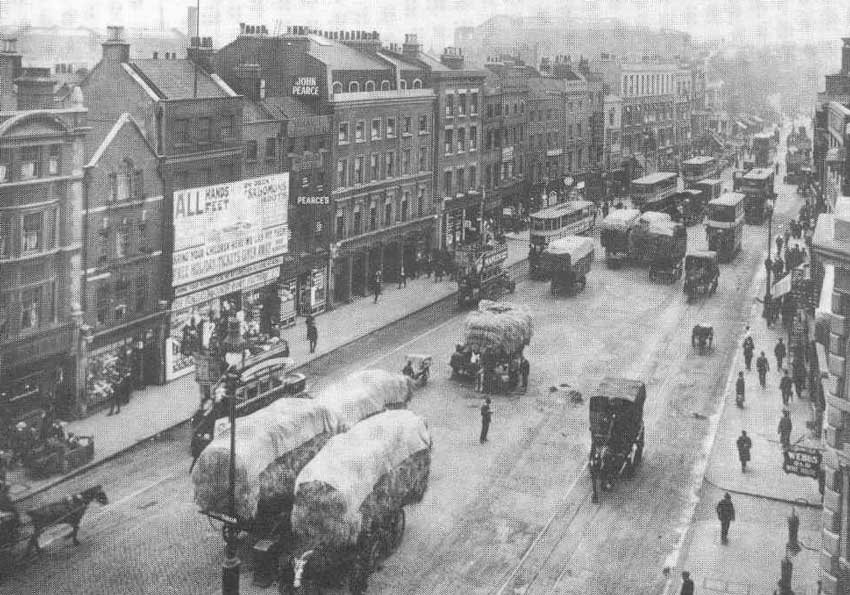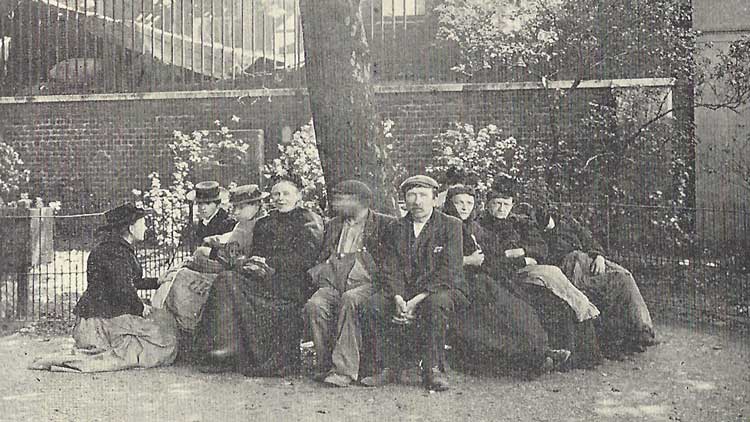Almost as important as studying the Whitechapel Jack the Ripper murders themselves, is gaining a knowledge of the streets of the East End of London as they were around the time of the crimes.
So much has changed in the district since the 1880’s; the nationalities of many of the residents are different; the layout of the streets is different; the shops are different; indeed, one could almost say that, were you to somehow transport a resident from one of the teeming courts or alleyways around 19th century Commercial Street; set him, or her, down at the Whitehchapel High Street end of Commercial Street, and then ask him, or her, to find their way home, chances are they would find it a pretty difficult task.
WE SIMPLY CANNOT IMAGINE
Likewise, for us to imagine what the streets were like back in the Victorian age is almost an impossibility.
Yes, we can look at buildings such as the Ten Bells, Christchurch and Spitalfields Market and glean an idea of the geographic appearance of the neighbourhood, but we simply cannot comprehend the 19th century atmosphere of the streets.
The smells, the sounds, or even the banter between the locals are, sadly (some might say thankfully) lost to us forever
OUR WINDOWS ON THE PAST
So, we need to fall back on the written accounts of the area that were published either before or after the 1888 murders, in order to gain an insight into the people and the area at the time.
Thankfully, newspapers back then were as curious about Whitechapel and Spitalfields as we are today and, as a result, there are numerous articles that we can read to gain a vivid impression of the teeming thoroughfares of East London in the closing two decades of the 19th century.
WHITECHAPEL WAY 1891
On December 12th 1891, for example, The Graphic published an article which took an in depth look at Whitechapel in that year.
The article provides us with a vivid glimpse of the area shortly after the Jack the Ripper murders had taken place here.
So, sit back and enjoy an armchair (or computer chair) journey down “Whitechapel Way”, circa 1891:-
“WHITECHAPEL in the morning – and on a fine morning – between eleven and twelve, puts on its freshest aspect, and shows the most vigorous signs of life. It is at its best and busiest.
Whitechapel Road and Mile End Road teem with all sorts and conditions of men and women; the shops are crowded, the streets are thronged, the spacious roadway is full of tramcars and omnibuses, carts and vans and barrows, and on Tuesdays, Thursdays, and Saturdays almost blocked with waggons which have brought from the country their huge loads of hay and straw to market.
A great deal of money changes hands on these hay-market days; money is evidently not scarce in Whitechapel on those occasions when money’s worth is to be procured.

THE RAGGED FRINGE
There is always a fair scramble going on in Butcher’s Row for chops and serviceable joints, and the costermongers are numerous and noisy; as the hour of twelve approaches, from the numerous courts and alleys debouch the army of “the ragged fringe ” – and eager plunges are made across the road in quest of the penny dinners at the Salvation quarters, where a prayer or two may be thrown in, if any one cares to wait for prayers.
We are not quite certain if this be the general rule, everyone seemed too busy for prayers – perhaps too hungry – in the flying visit that we made to the cookery quarters of the “Army.”
EVERYONE IS BUSY
But every one is busy in the Whitechapel Road; there is even a brisk trade going on in groundsel, purveyed by a strange dwarfish being, who may be a Nihilist or a Russian Jew, or even the “Wandering Jew,” and who sits with his back to a blank wall, stolid, and picturesque, and hairy; they are selling highly-coloured pictures and odd volumes of books from barrows, too, and penny and halfpenny toys and sweetmeats, and one man is expatiating eloquently upon the virtues of a medicine which is warranted to cure every ailment under the sun, except, apparently, an ebullition of temper from the gentleman a few yards off, who also has a specific to dispose of and who makes satirical and scathing comments in vigorous language upon his rival in the same line of business, and is decidedly personal and abusive.
And, amidst it all, out of the fray, sits a row of men and women on a bench in a sunny corner of Whitechapel churchyard.
TIME-BEATEN POOR
These wayfarers are, as a rule, old and time-beaten, poor, and destitute, very much out of the way of “a job of work,” and of help altogether, and they sit huddled together in the sunshine, impressive, unobservant, purely idle, devoid of interest in the life flowing on beyond the iron railings through which a passer-by peers at them curiously now and then, and wonders where they have come from, and what they are dreaming about?

RIVULETS’ OF HUMANITY
The busy life streams on along all the back streets of Whitechapel – rivulets’ of humanity leading towards the greater river; here food of inferior quality – mysterious compounds of food altogether, are displayed in the shop-windows; women with water-cresses or radishes squat with their wares composedly upon the kerbstones; men with barrows heaped with plates and dishes, jugs and mugs, basins and ewers, are vociferous over the quality of their wares, and test their articles cymbal fashion by clashing them together as a guarantee of soundness and good faith; a woman coolly stalks down the street with two live fowls for sale tucked under her arms crowing and fluttering, and pecking at her spitefully.
THE ICE-CREAM VENDOR
Here is a run upon the ice barrow – halfpenny and penny ices – the Board School children trouping out at midday, and the Italian in charge knowing where to come to an anchor with his highly coloured vehicle so as to secure a good share of patronage and support.
M. Renouard stops to sketch this “subject.”
The identical ice-cream vendor herein depicted has taken his pitch in Middlesex Street, where many children are out and about.
He glances over his barrow at our artist, and scarcely likes the process to which he is involuntarily subjected; he is not quite certain that it is good for trade or for him, or what it is intended for – whether there is not miching malicho [secret or underhand mischief] in it altogether.

THEY ARE ALWAYS ALERT
The people in the streets are also very curious – they are always on the alert Whitechapel way – they like to see all that there is to be displayed in the way of gratuitous amusement.
They halt at a respectful distance to begin with – they compare notes with each other, and make guesses at the newspaper for which the sketch is being rapidly struck off – they accumulate with marvellous rapidity, they surround us presently in a dense circle of inquiring faces, they struggle hard to catch glimpses of M. Renouard’s work, and they form a dense mob at last, until a policeman stalks into its midst, wondering “what’s the row,” and begins moving – even shoving – on a few of the most intrusive and intolerant.
GET OUT!
One woman, without bonnet or shawl, and with an extremely dirty face, looks at us from a distorted point of view.
She is a pessimist, and does not see any good in it.
She would rouse the ire of the populace against us, if it lay in her power, and she resents altogether our intrusion into Whitechapel quarters. “A cumin’ here a sketchin’ us poor people for your mucky papers. Yah! Get out. The couple on yer.”
And M. Renouard, having finished his sketch, closes his big portfolio – sometimes the writer wishes it were not quite so large, and did not “catch the eye” so quickly down Whitechapel – and we “get out” accordingly.
CROWD MEMBERS FOLLOW
Several members of the crowd – especially the juvenile portion – follow us for a short time, anxious as to what kind of performance we are going through on the next occasion – but there are many things to distract attention in Whitechapel, and the pasting up of an enormous poster, full of sensation scenes from the new Pavilion melodrama to be produced next Monday, saves us from further attendance of the rank and file.
A KEEN, DARK-EYED TAILOR
From all but one individual, a keen, dark-eyed, tolerably well-dressed man, who resembles a tailor out on strike, and to whom “hard lines” have evidently come.
He sidles up to us, raises his hat politely, and offers his services forthwith.
If he can be of any assistance he should be oh, so very glad!
He has nothing to do, he is out of work, he knows every turn and twist of the neighbourhood, he can provide us with a good subject or two he is sure, if we will only let him try.
He is disappointed when he finds there is no vacancy upon our staff, but he follows lowly in our wake, lurking in the background and “living in hopes,” and we do not lose sight of him altogether until we are whirled away further East.”
